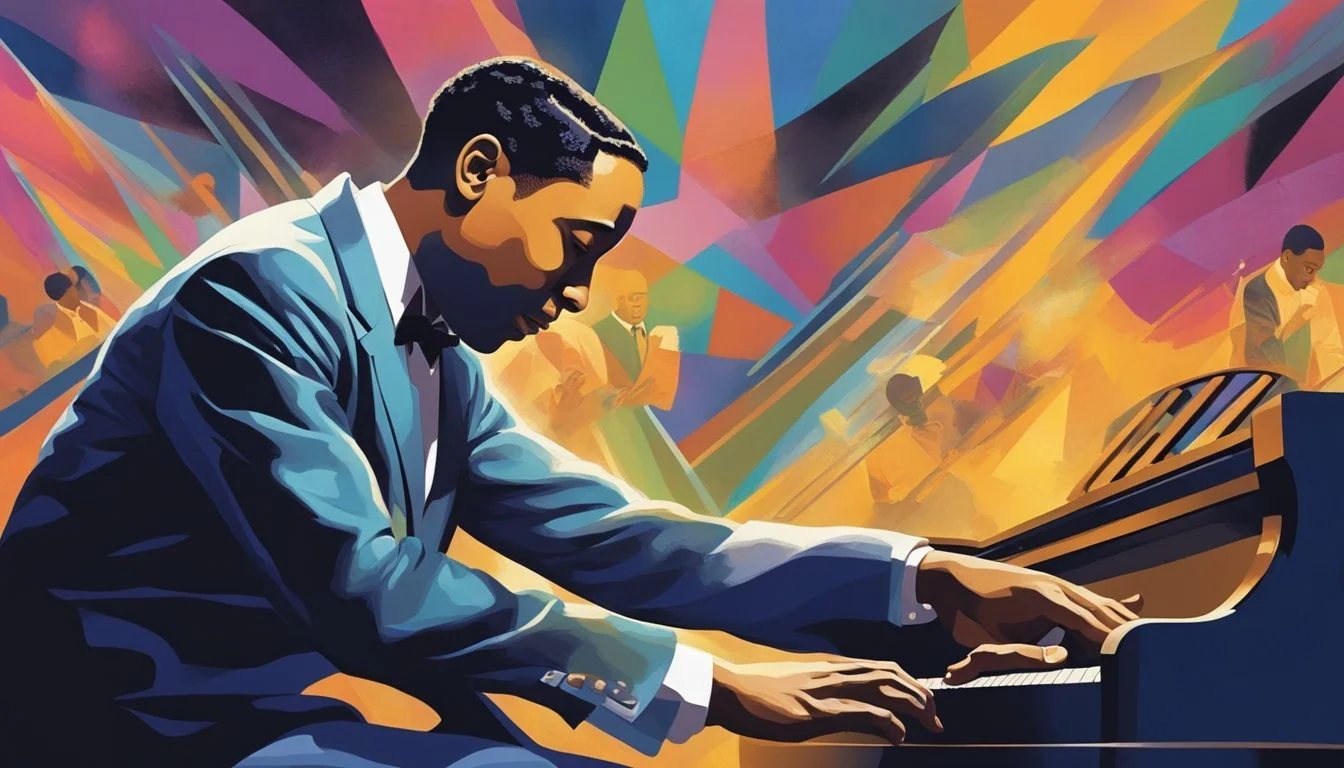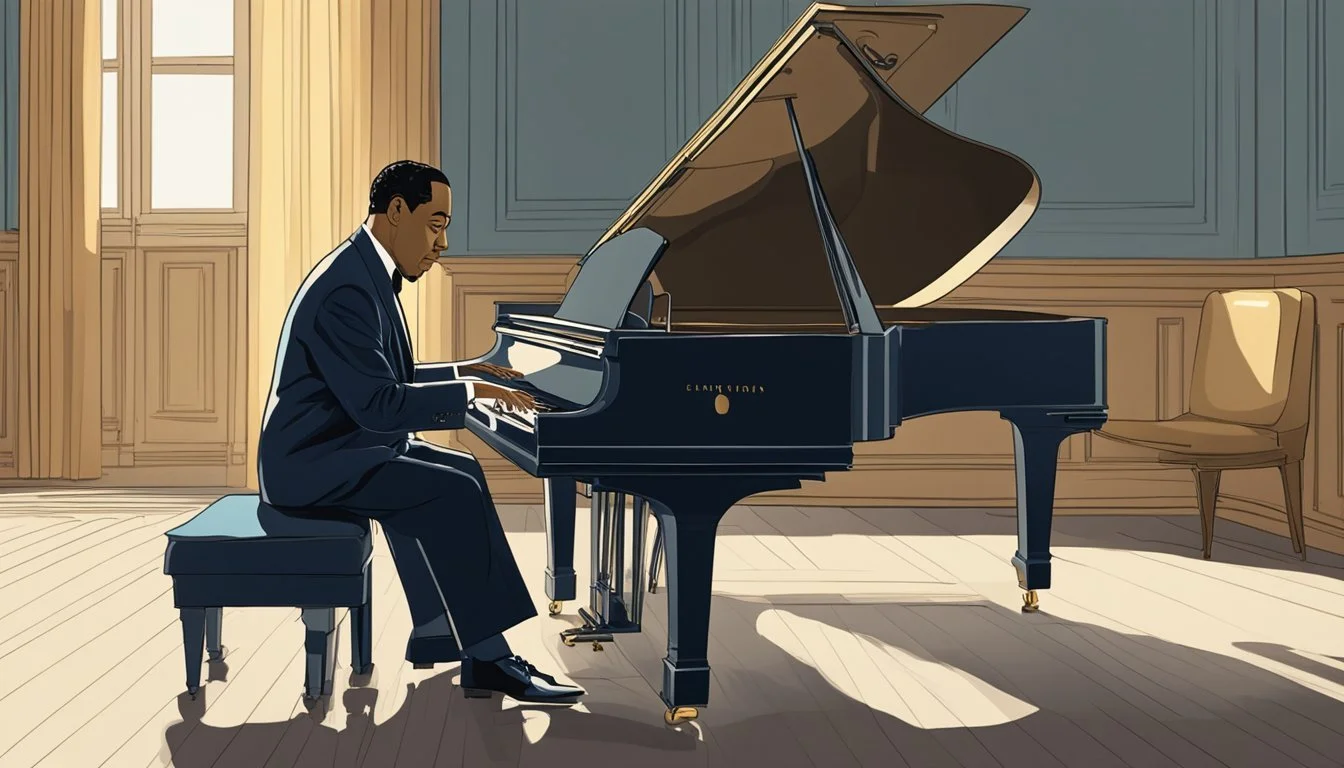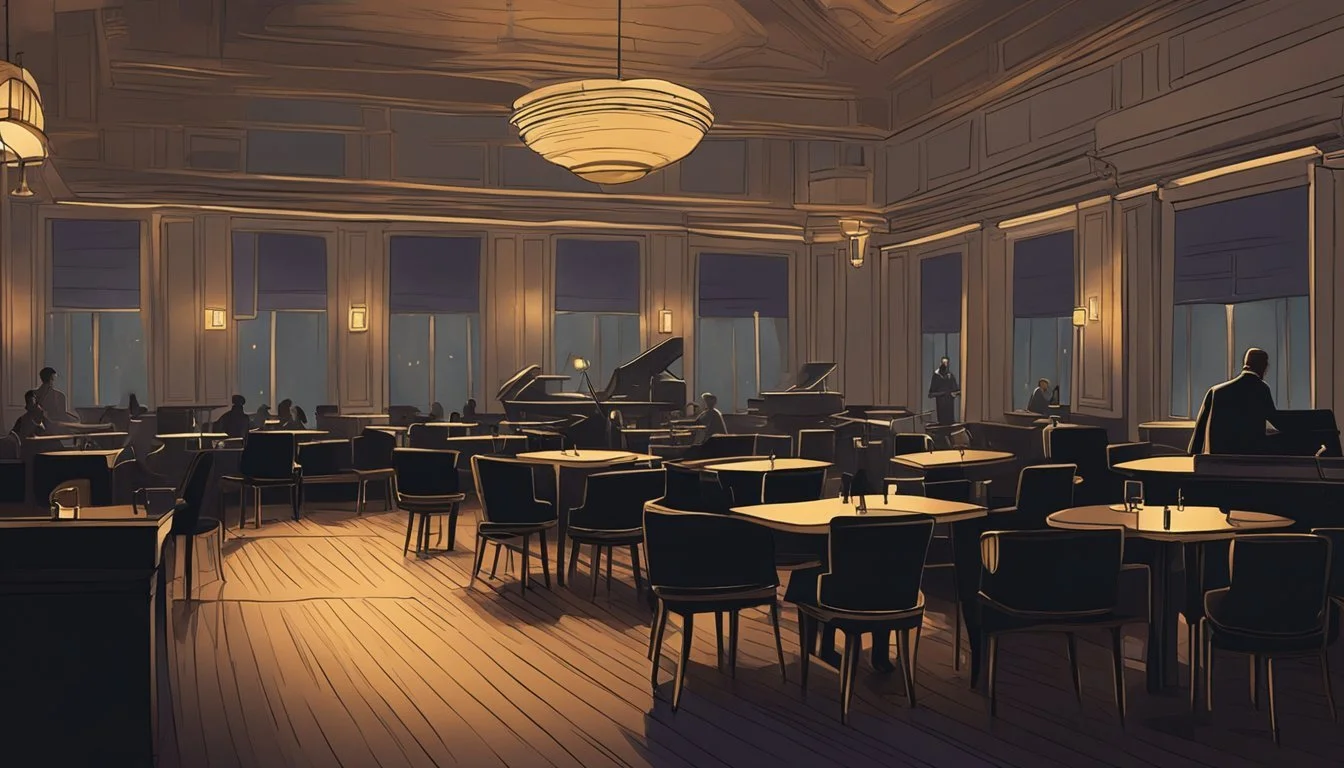Jazz and Jitters: Duke Ellington's Battle with Depression
The Hidden Struggle Behind the Music
Duke Ellington, one of America's most prolific and influential jazz composers, faced challenges during the Great Depression that shaped his music and career. As economic hardship swept the nation, Ellington and his band found innovative ways to adapt and thrive.
Despite the financial struggles of the 1930s, Ellington's creativity flourished, leading to some of his most memorable compositions. His ability to blend mournful themes with uplifting melodies resonated with audiences seeking solace during difficult times. The Duke's ingenious use of muted instruments and unique orchestrations created a distinctive sound that captured the complex emotions of the era.
Ellington's response to the Depression went beyond musical innovation. In 1933, he embarked on a successful European tour, expanding his international reputation and securing new opportunities for his band. This strategic move not only helped sustain his career but also spread the influence of American jazz across the globe.
Duke Ellington's Early Life and Entry into Jazz
Edward Kennedy "Duke" Ellington was born in 1899 in Washington, D.C. His parents, both piano players, encouraged his musical pursuits from a young age. Ellington's talent blossomed quickly, setting the stage for his remarkable jazz career.
The Washingtonians and the Kentucky Club Era
Ellington formed his first band, The Washingtonians, in the early 1920s. The group began playing at local venues in Washington, D.C. before moving to New York City in 1923.
In New York, The Washingtonians secured a residency at the Kentucky Club in 1924. This engagement proved crucial for Ellington's developing style and growing reputation.
During this period, Ellington honed his skills as a bandleader and composer. He began crafting the distinctive sound that would define his career.
Rise to Fame at the Cotton Club
In 1927, Ellington's band landed a coveted spot at Harlem's Cotton Club. This prestigious venue catapulted them into the national spotlight.
The Cotton Club era marked a turning point in Ellington's career. Regular radio broadcasts from the club spread his music across the country.
Ellington's innovative compositions and arrangements captivated audiences. His orchestra's unique sound, blending individual talents with collective harmony, set new standards in jazz.
At the Cotton Club, Ellington composed some of his most famous early works. These included "Mood Indigo" and "It Don't Mean a Thing (If It Ain't Got That Swing)."
Musical Style and Innovations
Duke Ellington's musical style was characterized by a unique blend of jazz, classical, and blues elements. His sophisticated orchestrations and innovative arrangements pushed the boundaries of jazz composition.
Blend of Jazz and Classical Elements
Ellington seamlessly fused jazz and classical music, creating a distinctive sound. He incorporated complex harmonies and extended musical forms typically associated with classical compositions into his jazz pieces. This approach elevated jazz to new artistic heights.
Ellington's use of dissonance and unusual chord progressions added depth to his music. He often employed classical techniques like counterpoint and fugue within jazz frameworks.
Sophisticated Orchestrations and Arrangements
Ellington's orchestrations were renowned for their rich textures and intricate layers. He treated his band as a palette of tonal colors, utilizing each instrument's unique timbre to create vivid musical landscapes.
His arrangements often featured unconventional instrument groupings and voicings. Ellington wrote specific parts for individual musicians, tailoring compositions to showcase their strengths.
He pioneered the use of the jazz orchestra as a unified ensemble rather than a backdrop for soloists.
Fusion of Blues and Swing in Composition
Ellington expertly wove blues and swing elements into his compositions. He incorporated blue notes and call-and-response patterns characteristic of the blues into sophisticated jazz structures.
His swing feel was distinctive, featuring a relaxed yet driving rhythm that became a hallmark of his style. Ellington's compositions often included subtle rhythmic shifts and syncopations that added complexity to the swing foundation.
He frequently used blues forms as the basis for extended compositions, expanding simple 12-bar structures into elaborate musical suites.
Duke Ellington's Famous Works
Duke Ellington's musical legacy spans decades, encompassing iconic compositions and influential big band hits. His works showcased innovative harmonies, rhythms, and orchestrations that pushed the boundaries of jazz.
Iconic Compositions and Collaborations
"Mood Indigo" stands as one of Ellington's most celebrated pieces. Composed in 1930, it features a unique blend of muted trumpet, clarinet, and trombone. The song's unconventional harmonic structure set a new standard in jazz composition.
"Sophisticated Lady" emerged in 1932, quickly becoming a jazz standard. Its complex chord progressions and elegant melody exemplified Ellington's sophisticated approach to composition.
Ellington's collaboration with Billy Strayhorn produced numerous classics. "Take the 'A' Train," written by Strayhorn, became the Duke Ellington Orchestra's signature tune. This partnership enriched Ellington's musical palette and contributed to his band's distinctive sound.
Notable Big Band Hits and Suites
Ellington's "Caravan," co-written with Juan Tizol, showcased the "Spanish tinge" in jazz. Its exotic rhythms and melodies captivated audiences and fellow musicians alike.
"Black, Brown and Beige" premiered at Carnegie Hall in 1943. This ambitious suite aimed to tell the story of African Americans through music. It demonstrated Ellington's ability to create extended, programmatic works that transcended traditional jazz formats.
Ellington's later suites, such as "Far East Suite" and "New Orleans Suite," further expanded the scope of big band jazz. These works incorporated diverse musical influences and showcased Ellington's continued innovation throughout his career.
The Jazz Orchestra: The Duke Ellington Orchestra
The Duke Ellington Orchestra became one of the most influential and enduring jazz ensembles in history. Its distinctive sound and innovative compositions shaped the big band era and beyond.
Evolution and Growth of the Band
Duke Ellington formed his first band in Washington, D.C. in the early 1920s. The group moved to New York City in 1927, landing a residency at the Cotton Club in Harlem. This exposure catapulted them to national fame.
Ellington's orchestra expanded from a sextet to a full big band over time. He carefully selected musicians whose unique sounds would blend into his musical vision.
The band's lineup changed throughout the decades, but always maintained a core of exceptional talent. Notable members included:
Johnny Hodges (alto saxophone)
Harry Carney (baritone saxophone)
Cootie Williams (trumpet)
Jimmy Blanton (bass)
Collaborations with Jazz Luminaries
The Duke Ellington Orchestra frequently collaborated with other jazz greats. These partnerships produced some of the most memorable recordings in jazz history.
In 1962, Ellington worked with John Coltrane on the album "Duke Ellington & John Coltrane". This meeting of jazz titans showcased the versatility of both artists.
Other notable collaborations included:
Ella Fitzgerald (vocalist)
Louis Armstrong (trumpet)
Coleman Hawkins (tenor saxophone)
Charles Mingus (bass)
These partnerships allowed Ellington to explore new musical territories while maintaining his signature sound. They demonstrated his ability to adapt and innovate across different jazz styles and eras.
Milestones and Acclaim
Duke Ellington's career was marked by groundbreaking performances and prestigious accolades. His innovative compositions and leadership in jazz music earned him widespread recognition both domestically and internationally.
Carnegie Hall and International Success
Ellington's 1943 Carnegie Hall debut marked a pivotal moment in jazz history. The concert featured his extended work "Black, Brown and Beige," showcasing his ability to blend jazz with classical forms. This performance solidified Ellington's status as a serious American composer.
In the 1950s, Ellington's band embarked on international tours, spreading jazz globally. Their appearances at the Newport Jazz Festival, particularly the 1956 performance, revitalized Ellington's career. The live recording of this concert became one of his best-selling albums.
Ellington continued to push musical boundaries, composing sacred concerts and suites that demonstrated his versatility as a jazz composer. His work in film scores and musical theater further expanded his influence in American music.
Awards and Recognitions
Ellington's contributions to music earned him numerous honors. In 1969, he received the Presidential Medal of Freedom, the highest civilian award in the United States. This recognition highlighted his impact on American culture and music.
Ellington was awarded 13 Grammy Awards throughout his career, including several posthumous honors. In 1965, he was nominated for a Pulitzer Prize in music, though he did not win. The Pulitzer board later awarded him a special posthumous honor in 1999.
His induction into various music halls of fame cemented his legacy. Ellington's innovative compositions and leadership in jazz continue to influence musicians and composers worldwide, long after his passing in 1974.
Journeys Through the Jazz Age and Swing Era
Duke Ellington's musical journey spanned the Jazz Age and Swing Era, shaping the evolution of jazz music. His innovative compositions and performances left an indelible mark on the genre.
Contribution to the Evolution of Jazz Music
Ellington pioneered a distinctive sound that bridged the Jazz Age and Swing Era. His compositions like "Mood Indigo" (1930) showcased rich orchestrations and haunting melodies. The anthem "It Don't Mean a Thing (If It Ain't Got That Swing)" (1931) helped define the swing movement.
Ellington's "jungle music" style incorporated African-inspired rhythms and unconventional harmonies. This approach expanded jazz's musical vocabulary and influenced future generations of musicians.
His emphasis on improvisation within structured arrangements allowed individual band members to shine while maintaining cohesive ensemble playing. This balance became a hallmark of Ellington's sound.
Performances at the Newport Jazz Festival
Ellington's appearances at the Newport Jazz Festival were legendary. His 1956 performance revitalized his career and introduced his music to a new generation of listeners.
The 14-minute rendition of "Diminuendo and Crescendo in Blue" featuring saxophonist Paul Gonsalves' 27-chorus solo became an iconic moment in jazz history. It electrified the audience and showcased Ellington's ability to blend tradition with innovation.
Subsequent Newport performances reinforced Ellington's status as a jazz innovator. These shows often featured premieres of new compositions, demonstrating his continued creativity and relevance in the evolving jazz landscape.
Challenges and Struggles
Duke Ellington faced significant obstacles throughout his career, both societal and personal. He navigated racial discrimination in the music industry while also grappling with internal emotional turmoil.
Overcoming Racial Barriers in America
Ellington encountered pervasive racism in the segregated America of the early 20th century. He often performed in venues where African Americans were not allowed as patrons. To combat stereotypes, Ellington cultivated a sophisticated image and insisted on being seen as an artist first.
He refused to be pigeonholed by racial expectations. When asked about "his people's" music, Ellington responded matter-of-factly, highlighting his individuality as a composer. His music transcended racial boundaries, gaining popularity with diverse audiences.
Ellington used his platform to advocate for civil rights. He composed pieces like "Black, Brown and Beige" to celebrate African American history and culture. Through his artistry and activism, he helped pave the way for future generations of Black musicians.
Battling Depression and Personal Trials
Behind his public persona, Ellington struggled with depression. The pressures of maintaining his career and band took a toll on his mental health. He often worked tirelessly, composing late into the night and touring extensively.
Ellington's perfectionism and high standards for his music sometimes led to periods of self-doubt. He faced financial challenges, especially during the Great Depression, which added to his stress.
Personal relationships also brought complications. Balancing family life with his musical career proved difficult. Despite these struggles, Ellington found solace in his work, channeling his emotions into his compositions.
His ability to create beauty amidst personal turmoil became a hallmark of his genius. Pieces like "Mood Indigo" reflect the depth of emotion he experienced and transformed into art.
Legacy and Impact on Music
Duke Ellington's contributions to jazz music left an indelible mark on the genre and influenced generations of musicians. His innovative compositions and arrangements expanded the boundaries of jazz, elevating it to new artistic heights.
Influence on Future Generations of Musicians
Ellington's sophisticated approach to jazz composition inspired countless musicians across genres. His unique blend of blues, swing, and classical elements created a rich musical palette that future artists drew from extensively. Many jazz pianists modeled their playing style after Ellington's elegant touch and harmonic sensibilities.
Ellington's collaborative leadership style also set a precedent for bandleaders. He nurtured individual talent within his orchestra, allowing musicians like Billy Strayhorn to flourish creatively. This approach influenced how jazz ensembles operated for decades to come.
Duke Ellington's Role in Jazz History
Ellington played a pivotal role in shaping jazz history. He brought sophistication and respectability to jazz, helping it gain recognition as a serious art form. His extensive body of work, comprising over 1,000 compositions, forms a cornerstone of the jazz canon.
As the "King of Jazz," Ellington broke racial barriers and became one of the most prominent African American cultural figures of the 20th century. His music spoke to the complexities of the human experience, addressing themes of love, joy, and social issues.
Ellington's impact extended beyond composition. He pioneered extended jazz forms, pushing the genre beyond short pieces into suites and concept albums. This expansion of jazz's scope paved the way for future experimentations in form and structure.








